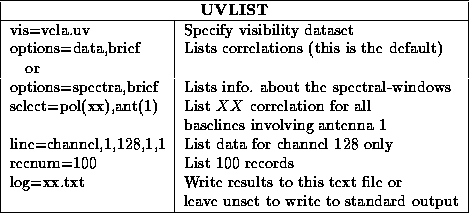



Next: CopyingConcatenating and
Up: ManipulatingExamining and
Previous: ManipulatingExamining and
- The task prthd
summarizes some basic information about your
visibility dataset (it also summarizes images). It only reads the
first few records of the data, so if you have multiple frequency
setups or sources, it will only report the first setting. It will tell
you the number of visibilities, the number of spectral-channels,
the number of spectral-windows (IFs), the polarisations
present and some information about frequencies. Output can be directed
to a log file (the terminal is the default), and either a brief or
full listing can be given (the default is the full listing). Several
inputs can be given (wildcards are supported).
- The task uvindex
scans through the visibility dataset and reports
changes in the source, pointing centre, number of spectral-channels,
observing frequency, and polarisation. Thus, it builds a description of
your observation for general reference. Give the visibility dataset
name with the keyword vis. The output can be directed to a text
file for printing via the keyword log.
- The task uvlist
can be used to list the values of the
correlations. The generic MIRIAD
keyword options is used to
control exactly what is listed (see the help file). The standard
keywords select and line are used to select the desired
visibility data and the desired part of the spectrum, respectively.
Here is an example.





Next: CopyingConcatenating and
Up: ManipulatingExamining and
Previous: ManipulatingExamining and
Last generated by rsault@atnf.csiro.au on 16 Jan 1996

